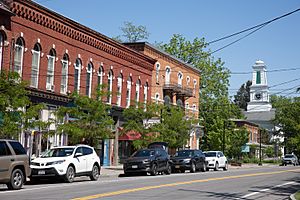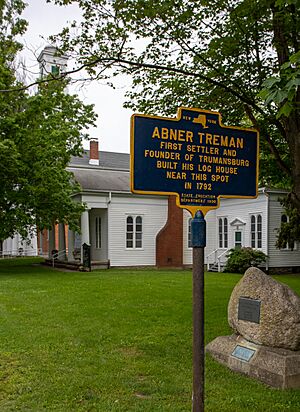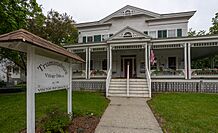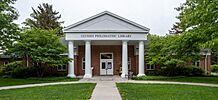Trumansburg, New York facts for kids
Quick facts for kids
Trumansburg, New York
|
|
|---|---|
|
Village
|
|

Trumansburg's Main Street
|
|
| Country | United States |
| State | New York |
| County | Tompkins |
| Settled | 1793 |
| Incorporated | 1872 |
| Named for | Early settler |
| Area | |
| • Total | 1.39 sq mi (3.60 km2) |
| • Land | 1.39 sq mi (3.59 km2) |
| • Water | 0.00 sq mi (0.01 km2) |
| Elevation | 965 ft (294 m) |
| Population
(2020)
|
|
| • Total | 1,714 |
| • Density | 1,235.76/sq mi (477.06/km2) |
| Time zone | UTC-5 (Eastern (EST)) |
| • Summer (DST) | UTC-4 (EDT) |
| ZIP code |
14886
|
| Area code(s) | 607 |
| FIPS code | 36-75506 |
| GNIS feature ID | 0974069 |
Trumansburg is a small village in Tompkins County, New York. In 2010, about 1,797 people lived there. The village's name comes from an early settler, Abner Treman. His last name was spelled differently over time. When the village applied for a post office, the spelling "Truman" was used, and it stuck. Trumansburg is part of the Town of Ulysses. It is located northwest of the city of Ithaca, New York.
Contents
History of Trumansburg
Trumansburg became an official village in 1872. It was built on land given to Abner Treman for his service in the American Revolutionary War. The village was first called "Tremaine's Village." It grew around a waterfall on a creek. This waterfall provided power for mills that ground grain.
In the 1800s, a man named Colonel Hermon Camp was very important in Trumansburg. He was an officer in the War of 1812. He became the local postmaster and started a bank. This bank is now the Tompkins Trust Company. His large, beautiful house, the Hermon Camp House, is still in the village. It was added to the National Register of Historic Places in 1973. Other historic places in Trumansburg include the First Presbyterian Church of Ulysses and the William Austin House.
Later in the 1900s, more people moved to Trumansburg. This was because the road to nearby Ithaca improved. Many people who worked at Cornell University and Ithaca College chose to live there. Famous musicians also made Trumansburg their home. From 1961 to 1970, Robert Moog built his famous electronic synthesizers in a shop downtown.
From 2004 to 2007, John R. Levine was the mayor of Trumansburg. He is known for writing The Internet for Dummies book.
Life in Trumansburg
For many years, Trumansburg was a center for farming and mills. After World War II, it became a place where people lived and worked in Ithaca. It also became a small tourist spot. You can find restaurants and antique shops there.
Since 1991, the Finger Lakes GrassRoots Festival of Music and Dance has been held here. It happens every July at the village fairgrounds. The band Donna the Buffalo hosts this popular event. The village is also on the Cayuga Wine Trail. It is very close to the beautiful Taughannock Falls.
Other places to visit include the Ulysses Philomathic Library. This library is part of the Finger Lakes Library System. The Trumansburg Conservatory of Fine Arts offers concerts and music lessons. The Ulysses Historical Society Museum has many items from local history.
Several churches are in the village. These include Baptist, Catholic, Episcopalian, Methodist, and Presbyterian churches.
The Trumansburg Central School District has three schools. These are the Elementary School, Russel I. Doig Middle School, and Charles O. Dickerson High School. All three schools are on one campus. School sports teams are called the Blue Raiders. The Trumansburg Central School District Foundation helps support local school programs.
Geography and Climate
Trumansburg is located at 42°32′26″N 76°39′36″W / 42.54056°N 76.66000°W. It covers about 1.2 square miles (3.1 km²). Most of this area is land. The village is on Trumansburg Creek. This creek flows into Cayuga Lake. Trumansburg is in the northern part of Tompkins County. It is about 12 miles (19 km) north of Ithaca.
The amazing Taughannock Falls State Park is just southeast of the village. It has one of the tallest waterfalls east of the Rocky Mountains.
Weather in Trumansburg
| Climate data for Trumansburg, New York | |||||||||||||
|---|---|---|---|---|---|---|---|---|---|---|---|---|---|
| Month | Jan | Feb | Mar | Apr | May | Jun | Jul | Aug | Sep | Oct | Nov | Dec | Year |
| Mean daily maximum °F (°C) | 32 (0) |
35 (2) |
42 (6) |
56 (13) |
68 (20) |
77 (25) |
81 (27) |
80 (27) |
73 (23) |
60 (16) |
48 (9) |
37 (3) |
57 (14) |
| Mean daily minimum °F (°C) | 17 (−8) |
18 (−8) |
25 (−4) |
37 (3) |
47 (8) |
57 (14) |
61 (16) |
59 (15) |
52 (11) |
42 (6) |
34 (1) |
24 (−4) |
39 (4) |
| Average precipitation inches (mm) | 1.91 (49) |
1.87 (47) |
2.52 (64) |
3.26 (83) |
3.16 (80) |
3.76 (96) |
3.52 (89) |
3.16 (80) |
4.01 (102) |
3.42 (87) |
3.22 (82) |
2.42 (61) |
36.23 (920) |
Trumansburg has cold, snowy winters. Its summers are warm and pleasant. The average temperature each year is about 48°F (9°C). The village gets about 36 inches (91 cm) of rain and snow each year.
Getting Around Trumansburg
NY Route 96 is a main highway that goes through Trumansburg. This road was updated in 1961. It runs north to Waterloo and south to Ithaca. You can take a local bus (TCAT Route 21) to Ithaca. From there, you can connect to longer bus trips or flights.
In the 1800s, Trumansburg had a port at Frontenac Point. This was where the Trumansburg Creek met Cayuga Lake. Boats could travel from the lake to the Erie Canal. The old docks and buildings are gone now. The area is now a camp for Boy Scouts.
A railroad line, the Lehigh Valley Railroad, used to run through Trumansburg. It operated from 1873 until 1962. Now, much of the old railway path is being turned into a biking and hiking trail. It is called the Black Diamond Trail. This name comes from a famous passenger train that used to run on the line.
Population of Trumansburg
| Historical population | |||
|---|---|---|---|
| Census | Pop. | %± | |
| 1870 | 1,246 | — | |
| 1880 | 1,376 | 10.4% | |
| 1890 | 1,211 | −12.0% | |
| 1900 | 1,225 | 1.2% | |
| 1910 | 1,188 | −3.0% | |
| 1920 | 1,011 | −14.9% | |
| 1930 | 1,077 | 6.5% | |
| 1940 | 1,130 | 4.9% | |
| 1950 | 1,479 | 30.9% | |
| 1960 | 1,768 | 19.5% | |
| 1970 | 1,803 | 2.0% | |
| 1980 | 1,722 | −4.5% | |
| 1990 | 1,611 | −6.4% | |
| 2000 | 1,581 | −1.9% | |
| 2010 | 1,797 | 13.7% | |
| 2020 | 1,714 | −4.6% | |
| U.S. Decennial Census | |||
In 2000, there were 1,581 people living in Trumansburg. There were 682 households, which are groups of people living together. About 33.6% of these households had children under 18. The average age of people in the village was 42 years old.
Education in Trumansburg
The schools in Trumansburg are part of the Trumansburg Central School District.
Notable People from Trumansburg
Many interesting people have connections to Trumansburg:
- Hermann Biggs – A doctor who helped improve public health.
- Ruth Stiles Gannett – A children's book author, famous for My Father's Dragon.
- John Gurche – An artist known for his drawings and sculptures of dinosaurs and early humans.
- Alfred E. Kahn – An economist who helped change rules for airlines.
- John R. Levine – An internet author and former mayor of Trumansburg.
- Robert Moog – An engineer who created electronic music synthesizers.
- Edward Ormondroyd – A children's book author, known for David and the Phoenix.
- Sandra Steingraber – A biologist and author who teaches at Cornell University.
- Richard Taylor – A well-known philosopher and author.
|
See also
 In Spanish: Trumansburg para niños
In Spanish: Trumansburg para niños







